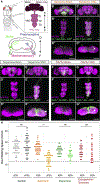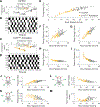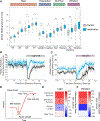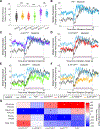Serotonergic Modulation of Walking in Drosophila
- PMID: 31786064
- PMCID: PMC6935052
- DOI: 10.1016/j.cub.2019.10.042
Serotonergic Modulation of Walking in Drosophila
Abstract
To navigate complex environments, animals must generate highly robust, yet flexible, locomotor behaviors. For example, walking speed must be tailored to the needs of a particular environment. Not only must animals choose the correct speed and gait, they must also adapt to changing conditions and quickly respond to sudden and surprising new stimuli. Neuromodulators, particularly the small biogenic amine neurotransmitters, have the ability to rapidly alter the functional outputs of motor circuits. Here, we show that the serotonergic system in the vinegar fly, Drosophila melanogaster, can modulate walking speed in a variety of contexts and also change how flies respond to sudden changes in the environment. These multifaceted roles of serotonin in locomotion are differentially mediated by a family of serotonergic receptors with distinct activities and expression patterns.
Keywords: 5-HT; 5-HT receptors; Drosophila; locomotion; neuromodulation; serotonin; startle response; walking; walking gaits.
Copyright © 2019 Elsevier Ltd. All rights reserved.
Conflict of interest statement
Declaration of Interests
The authors declare no competing interests.
Figures






References
-
- Ritzmann RE, and Büschges A (2007). Adaptive motor behavior in insects. Curr. Opin. Neurobiol 17, 629–636. - PubMed
-
- Ritzmann RE, Quinn RD, and Fischer MS (2004). Convergent evolution and locomotion through complex terrain by insects, vertebrates and robots. Arthropod Struct Dev 33, 361–379. - PubMed
-
- Bidaye SS, Machacek C, Wu Y, and Dickson BJ (2014). Neuronal control of Drosophila walking direction. Science 344, 97–101. - PubMed
-
- Isakov A, Buchanan SM, Sullivan B, Ramachandran A, Chapman JKS, Lu ES, Mahadevan L, and de Bivort B (2016). Recovery of locomotion after injury in Drosophila depends on proprioception. J. Exp. Biol - PubMed
Publication types
MeSH terms
Substances
Grants and funding
LinkOut - more resources
Full Text Sources
Molecular Biology Databases

